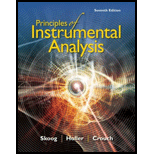
Principles of Instrumental Analysis
7th Edition
ISBN: 9781305577213
Author: Douglas A. Skoog, F. James Holler, Stanley R. Crouch
Publisher: Cengage Learning
expand_more
expand_more
format_list_bulleted
Question
Chapter 1, Problem 1.5QAP
Interpretation Introduction
Interpretation:
The data domain should be explained.
Concept introduction:
Analytical instruments are used to provide information based on composition of sample of matter. These instruments are employed in order to obtain both qualitative as well as quantitative information of one or more components which are present or absent in a given sample. Analytical instruments comprise of four basic elements and they are:
- Chemical information source.
- Transducers.
- Signal conditioners.
- Display system.
The main steps involved in measurements (transformation and processing) of the signals takes place between different data domains.
Expert Solution & Answer
Trending nowThis is a popular solution!

Students have asked these similar questions
Protecting Groups and Carbonyls
6) The synthesis generates allethrolone that exhibits high insect toxicity but low mammalian toxicity. They are used in pet
shampoo, human lice shampoo, and industrial sprays for insects and mosquitos. Propose detailed mechanistic steps to
generate the allethrolone label the different types of reagents (Grignard, acid/base protonation, acid/base deprotonation,
reduction, oxidation, witting, aldol condensation, Robinson annulation, etc.)
III + VI
HS
HS
H+
CH,CH,Li
III
I
II
IV
CI + P(Ph)3
V
༼
Hint: no strong base added
VI
S
VII
IX
HO
VIII
-MgBr
HgCl2,HgO
HO.
isomerization
aqeuous solution
H,SO,
༽༽༤༽༽
X
MeOH
Hint: enhances selectivity for reaction at the S
X
☑
Draw the complete mechanism for the acid-catalyzed hydration of this alkene.
esc
田
Explanation
Check
1
888
Q
A
slock
Add/Remove step
Q
F4
F5
F6
A
བྲA
F7
$
%
5
@
4
2
3
&
6
87
Click and drag to start
drawing a structure.
© 2025 McGraw Hill LLC. All Rights Reserved. Terms of Use | Privacy Ce
W
E
R
T
Y
U
S
D
LL
G
H
IK
DD
요
F8
F9
F10
F1
*
(
8
9
0
O
P
J
K
L
Z
X
C
V
B
N
M
H
He
command
Explanation
Check
F1
H₂O
H₂
Pd
1) MCPBA
2) H3O+
1) Hg(OAc)2, H₂O
2) NaBH4
OH
CI
OH OH
OH
hydration
halohydrin formation
addition
halogenation
hydrogenation
inhalation
hydrogenation
hydration
☐ halohydrin formation
addition
halogenation
formation chelation
hydrogenation
halohydrin formation
substitution
hydration
halogenation
addition
Ohalohydrin formation
subtraction
halogenation
addition
hydrogenation
hydration
F2
80
F3
σ
F4
F5
F6
1
!
2
#
3
$
4
%
05
Q
W
&
Å
© 2025 McGraw Hill LLC. All Rights Reserved.
F7
F8
(
6
7
8
9
LU
E
R
T
Y
U
A
F9
Knowledge Booster
Similar questions
- Show the mechanism steps to obtain the lowerenergy intermediate: *see imagearrow_forwardSoap is made by the previous reaction *see image. The main difference between one soap and another soap isthe length (number of carbons) of the carboxylic acid. However, if a soap irritates your skin, they mostlikely used too much lye.Detergents have the same chemical structure as soaps except for the functional group. Detergentshave sulfate (R-SO4H) and phosphate (R-PO4H2) functional groups. Draw the above carboxylic acidcarbon chain but as the two variants of detergents. *see imagearrow_forwardWhat are the reactions or reagents used? *see imagearrow_forward
- The two pKa values of oxalic acid are 1.25 and 3.81. Why are they not the same value? Show the protontransfer as part of your explanation. *see imagearrow_forwardасть Identify all the bonds that gauche interact with C-OMe in the most stable conformation of the above compound.arrow_forwardPredict the reactants used in the formation of the following compounds using Acid-Catalyzed dehydration reactionarrow_forward
- Can I please get help with this?arrow_forward.. Give the major organic product(s) for each of the following reactions or sequences of reactions. Show ll relevant stereochemistry [3 ONLY]. A H Br 1. NaCN 2 NaOH, H₂O, heat 3. H3O+ B. CH₂COOH 19000 1. LiAlH4 THF, heat 2 H₂O* C. CH Br 1. NaCN, acetone 2 H3O+, heat D. Br 1. Mg. ether 3. H₂O+ 2 CO₂ E. CN 1. (CH) CHMgBr, ether 2 H₂O+arrow_forwardAssign this COSY spectrumarrow_forward
arrow_back_ios
SEE MORE QUESTIONS
arrow_forward_ios
Recommended textbooks for you
 Principles of Instrumental AnalysisChemistryISBN:9781305577213Author:Douglas A. Skoog, F. James Holler, Stanley R. CrouchPublisher:Cengage Learning
Principles of Instrumental AnalysisChemistryISBN:9781305577213Author:Douglas A. Skoog, F. James Holler, Stanley R. CrouchPublisher:Cengage Learning Introductory Chemistry: A FoundationChemistryISBN:9781337399425Author:Steven S. Zumdahl, Donald J. DeCostePublisher:Cengage Learning
Introductory Chemistry: A FoundationChemistryISBN:9781337399425Author:Steven S. Zumdahl, Donald J. DeCostePublisher:Cengage Learning Chemistry: The Molecular ScienceChemistryISBN:9781285199047Author:John W. Moore, Conrad L. StanitskiPublisher:Cengage Learning
Chemistry: The Molecular ScienceChemistryISBN:9781285199047Author:John W. Moore, Conrad L. StanitskiPublisher:Cengage Learning- Chemistry: Matter and ChangeChemistryISBN:9780078746376Author:Dinah Zike, Laurel Dingrando, Nicholas Hainen, Cheryl WistromPublisher:Glencoe/McGraw-Hill School Pub Co
 Chemistry for Engineering StudentsChemistryISBN:9781337398909Author:Lawrence S. Brown, Tom HolmePublisher:Cengage Learning
Chemistry for Engineering StudentsChemistryISBN:9781337398909Author:Lawrence S. Brown, Tom HolmePublisher:Cengage Learning

Principles of Instrumental Analysis
Chemistry
ISBN:9781305577213
Author:Douglas A. Skoog, F. James Holler, Stanley R. Crouch
Publisher:Cengage Learning

Introductory Chemistry: A Foundation
Chemistry
ISBN:9781337399425
Author:Steven S. Zumdahl, Donald J. DeCoste
Publisher:Cengage Learning

Chemistry: The Molecular Science
Chemistry
ISBN:9781285199047
Author:John W. Moore, Conrad L. Stanitski
Publisher:Cengage Learning

Chemistry: Matter and Change
Chemistry
ISBN:9780078746376
Author:Dinah Zike, Laurel Dingrando, Nicholas Hainen, Cheryl Wistrom
Publisher:Glencoe/McGraw-Hill School Pub Co

Chemistry for Engineering Students
Chemistry
ISBN:9781337398909
Author:Lawrence S. Brown, Tom Holme
Publisher:Cengage Learning